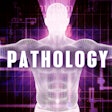
LOS ANGELES -- To ensure a healthy future for pathology, the specialty must become more diverse and visible to students of all backgrounds and ages, from kindergarten up to the clinical years, according to a Saturday session at the 2022 United States and Canadian Academy of Pathology (USCAP) meeting.
Pathologists at the session discussed where pathology is headed and strategies to ensure a more representative and diverse profession.
Leading the session was Dr. Valerie Fitzhugh, a cytopathologist at Rutgers University, who led with an overview of the current state of affairs. She laid out some of the facts about an already small profession that has both a visibility issue and diversity issue.
A self-described unicorn -- Fitzhugh is only the third Black woman to chair a pathology department at an academic institution -- she said these issues work in tandem to harm the future of the profession.
One solution: ensure that pathologists and pathology leaders are diverse and representative of groups who have historically been underrepresented in medicine.
"They need to see enough of us in a diverse setting that they understand that there are pathologists that look like them," Fitzhugh said. "This is something that we have to think about and consider."
Pathology by the numbers
The latest physician data report from the Association of American Medical Colleges (AAMC) states there were 12,766 practicing pathologists in 2020, and, of that number, only 4,880 were women. Meanwhile, the total number of doctors in practice from the same year was 936,254, of which the total number of female doctors across all specialties was 340,018.
In 2019, the AAMC reported that there were only 125 Black male pathologists and 192 Black female pathologists. The numbers are even more dismal for Indigenous populations, with only six men and eight women identifying as Indigenous American or Alaska Native.
Pathologists need to get potential students interested in the profession and underrepresented groups need to know that there are pathologists that look like them, Fitzhugh said.
"We have to get them interested to save our specialty," Fitzhugh said. "We have to diversify our specialty to save our specialty."
Med school blues
Fitzhugh noted that pathology, which was already forecast to be short of specialists by 2023, got hammered by the COVID-19 pandemic. During this time, a large number of pathologists retired, reducing the size of the workforce even further. (The number was so great it was sometimes referred to as a "silver tsunami.")
"We're going to get critically close to a point where there won't be enough pathologists," she said. "And that scares me."
On top of an already challenging situation, medical schools are cutting pathology from the curriculum, she said.
"What I am hearing from a lot of my colleagues who are in education is that pathology is being snipped away," she said. "In those first two years, pathologists are not seen in the curriculum as they used to be."
Medical students have very little exposure to pathologists as it is, and with the cuts the problem is worsened, she explained.
"You have an issue of students who are underrepresented, not seeing pathologists who look like them," Fitzhugh said. "Then you also have pathologists being cut out of the curriculum. Because if we're not present, how are people going to decide to even be a little bit interested in being a pathologist?"
Planting that pathology seed
As an example of how visibility and representation can help build a workforce, Fitzhugh spoke about why many of her students choose obstetrics and gynecology (ob/gyn) as a specialty.
"I have so many students who choose ob/gyn because the number of black and particularly black women ob/gyn they see is huge compared to anything else," she explained. "We have to create that similar sisterhood and brotherhood topology where people see more people that look like them, so they're encouraged to join."
Fitzhugh said that she visits schools as part of her efforts to plant the seeds that will one day sprout the next generation of pathologists.
"I can go to elementary schools and talk to the kids about pathology and they are interested," she said. "There is at least one kid in the room who's had her tonsils out, and I will go, 'I've got a picture for you,' and I'll show them a picture of a tonsil ... and they get all excited. We have to get them when they are this age."



















